Rittal Cable clamps
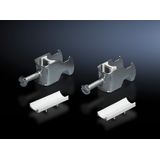

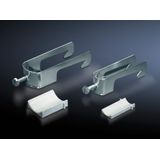
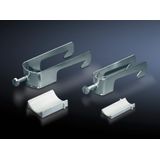
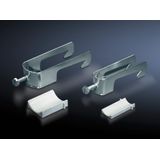
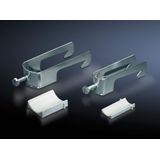
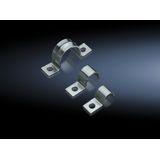

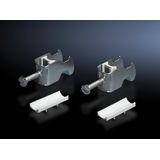

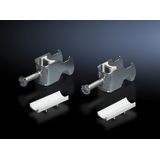
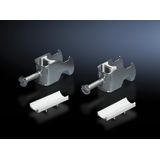
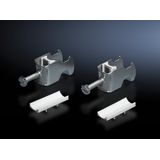
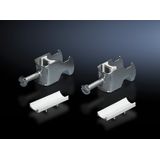

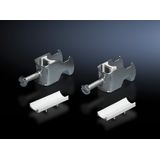

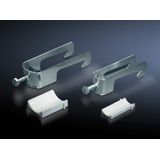





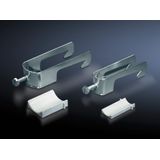
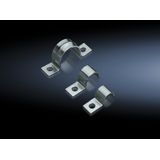


rittal cable clamps for tidy, compliant routing
Installers use Rittal clamps to fix power and control cables where bend radii, strain‑relief and corrosion resistance actually matter: panel entries, vertical risers, machine frames, and outdoor poles. The aim is predictable pull‑out strength, clean dressing, and fast service without compromising IP/EMC targets.
Product range and series overview – rittal round cable clamps
Single‑hole round clamps. Compact bodies for one cable; common OD ranges from 6–50 mm with elastomer inserts that grip without cold‑flow. Mount to mounting plates, TS35 rails via adapters, or C‑rails.
Double/stacked clamps. Shared bases hold two parallel runs to save width in dense panels; spacers maintain air gaps for heat and inspection.
Saddle and half‑shell types. Quick‑fit over existing routes; useful above terminal rows and at rising trunks where access is limited.
Inline strain‑relief bars. Cross‑bars with multiple clamp positions ahead of terminal blocks; keep conductor loads off screw/spring terminals per EN 62444.
Materials include UV‑stable polymer bodies with elastomer liners for general use and metal bodies with rubber profiles where vibration and high temperatures are expected.
Technical specifications and standards
- Materials: polymer clamps in PA6/PA6‑GF with EPDM/TPU liners; metal bodies in zinc‑plated steel or stainless A2/A4. Choose polymer where weight and cost matter; choose metal for heat, oil, and outdoor exposure.
- Temperature & environment: typical operating −40…+90 °C (liners may limit upper range). UV‑stable options for façades; chemical resistance tables available per material.
- Fixings & interfaces: base holes for M5/M6; adapters for EN 60715 TS35 and Rittal C‑rails. Keep fastener torque within spec to avoid creep.
- Strain‑relief: selection and testing align with EN 62444; document clamp locations in panel FAT so maintenance crews know where loads are intercepted.
- Ingress & EMC context: clamps sit inside the IP path; use correctly sized metric glands (M16–M50) at entries and bond screens to EMC plates where required.
- Fire behaviour: selected polymer families meet UL 94 V‑0; stainless versions handle high‑risk/cleaning environments.
Field habit: keep unsupported cable between gland and first clamp as short as practical; it prevents lever action on the entry and extends gland life.
Applications and compatibility – rittal cable routing clamps
- Panels and distribution boards: create tidy strain‑relief rows before terminals; pair with brush/split gland plates to restore IP after cable entry.
- Machine frames and door loops: use elastomer‑lined clamps to protect jackets; add flex conduits where motion or abrasion is present.
- Outdoor poles and kiosks: stainless bodies plus EPDM liners stop creep in heat/cold cycles; place clamps above drip lines.
- VFD/servo runs: separate power and feedback; use non‑conductive bodies where EMC partitioning relies on spacing.
All clamp families align with Rittal hole patterns and rail adapters, so platform mixing stays tool‑compatible.
Integration with other Rittal products
Clamps sit just ahead of terminal rows on TS35 rails, beside routing duct, and on mounting plates with depth rails. Combine with matching gland plates, EMC bonding hardware and marker systems to keep assembly consistent across cabinets. When rails are bayed, mirror clamp layouts so service teams can work by habit.
Use stainless hardware alongside sealed IP65/66 entries in wash‑down areas; switch to polymer clamps in low‑risk interiors to save cost and weight.
Selection criteria for B2B clients – rittal heavy duty cable clamps
- Cable OD and count — size clamps to the largest jacket; consider double bodies for parallel feeds; avoid over‑compression on soft jackets.
- Environment — indoor dry → polymer; outdoor/chemical → metal bodies with EPDM; coastal/food → A4 stainless.
- Strain‑relief scheme — define intercept points to EN 62444; keep the first clamp close to the entry, then space at sensible intervals.
- Interfaces & hardware — verify base holes and adapter type (TS35 vs C‑rail); unify head type (Torx/hex) across the estate.
- EMC & segregation — keep power and control routes distinct; where shields bond to EMC plates, place the first clamp immediately after the bond.
Procurement teams often standardize one polymer line, one metal line, and a stainless option to cover most sites with minimal spares
Material choices in practice
For harsh sites, rittal stainless steel cable clamps with EPDM liners resist corrosion and vibration. In office and light‑industrial panels, rittal plastic cable clamps (PA6 or PA6‑GF) keep weight and cost down while maintaining reliable grip on the jacket.
Advantages of working with Bankoflamps
You get project‑specific B2B pricing and formal offers, a dedicated account manager, and live stock visibility across EU warehouses. Quotes typically arrive in about an hour; orders place by EAN/MPN, and price lists stay downloadable and current. We track lead times and order status, provide purchase‑history analytics, and extend post‑payment up to 30 days for trusted clients. We also plan consolidated shipments to cut freight costs, keep pricing stable with validity dates, and support teams in France, the Baltics, Germany, Spain, Italy, Belgium, and the Netherlands.